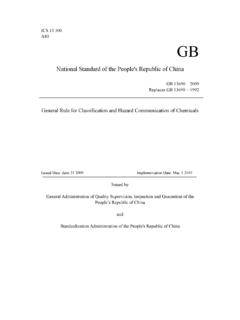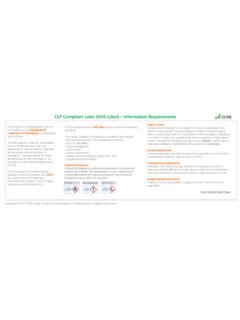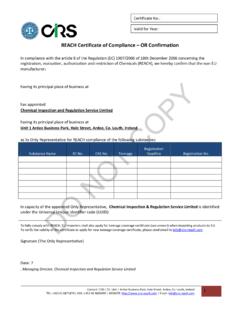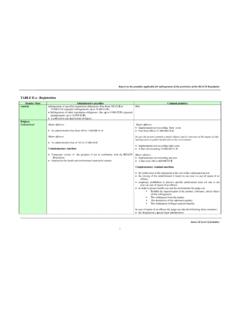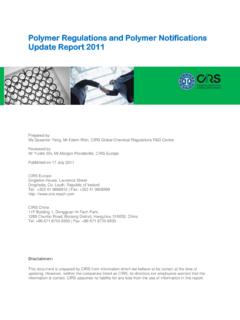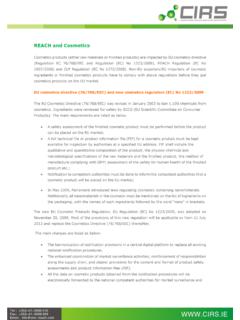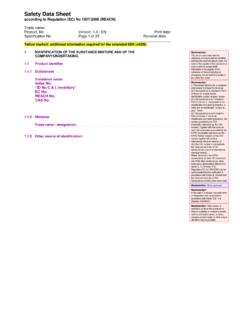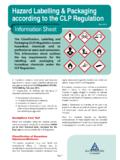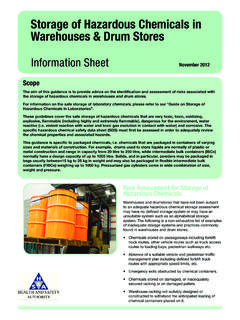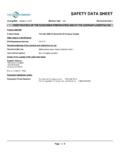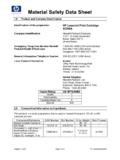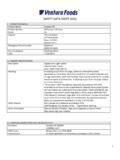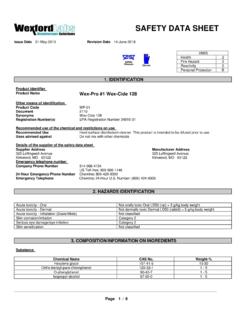Transcription of General Rule for Preparation of Precautionary Label for ...
1 ICS A80 GB National Standard of the People's Republic of China GB 15258 2009 To Replace GB 15258 1999 General Rule for Preparation of Precautionary Label for Chemicals Issued on June 21 2009 To take effect on May 1 2010 Issued by General Administration of Quality Supervision, Inspection and Quarantine of the People s Republic of China And Standardization Administration of the People's Republic of China GB 15258 2009 Foreword Articles , , , , and Sections and in the Standard are mandatory, whilst the rest are recommended. The conformity degree between this Standard and its corresponding regulation, the second revised edition of Globally Harmonized System of Classification and Labeling of Chemicals (GHS), is non-equivalent.
2 The Standard replaces GB l5258 1999 General Rule for Preparation of Precautionary Label for Chemicals. The main differences between this Standard when compared to GB 15258-1999 are: - the Label contents in Article have been modified; - Label dimensions has been added to Article ; - Simplified labels has been added to Article ; and - Appendices A, B, C have been modified to include designed examples of Precautionary labels, and pasting examples of Precautionary labels and transport symbols, and Precautionary statements have been provided for different categories of chemicals. Appendices A, B and C to the Standard are informative appendices. The implementation date of this Standard is XX date, XX month of 200X year; its transition period for implementation from the implementation date shall be one year.
3 This Standard is proposed by and is under the jurisdiction of the Dangerous Chemicals Management of Standardization Administration of China (SAC/TC251). The organizations that participated in the drafting of this Standard: Qingdao Safety Engineering Institute of SINOPEC (China Petroleum & Chemical Corporation); and State Key Laboratory of Chemical Safety and Control The main drafters of this Standard: JI Guo-Feng, LI Yun-Cai, GUO Xiu-Yun, LI Yong-Xing, LI Xue-Hua, CHEN Jun, PENG Xiang-Wei, CAO Yong-You and ZHANG Hai-Feng. This Standard replaces the previously issued Standards: - GB/T l5258 1994 and GB l5258 1999. General Rule for Preparation of Precautionary Label for Chemicals 1.
4 Scope This Standard specifies the relevant definitions, content, Preparation requirements and application methods of Precautionary labels for chemicals. This Standard applies to the compiling, Preparation and application of Precautionary labels for chemicals. Where the Precautionary Label of a product is specified by a special standard, for pesticides, gas cylinders, etc., these shall be conducted in accordance with said special standard. 2. Normative References The provisions of the following documents become provisions of this Standard after being referenced. For dated reference documents, all later amendments (excluding corrigenda) and versions do not apply to this Standard; however, the parties to the agreement are encouraged to study whether the latest versions of these documents are applicable.
5 For undated reference documents, the latest versions apply to this Standard. GB/T 12268 List of dangerous goods GB 20576 Safety rules for classification, Precautionary labeling and Precautionary statements of chemicals Explosives GB 20577 Safety rules for classification, Precautionary labeling and Precautionary statements of chemicals Flammable gases GB 20578 Safety rules for classification, Precautionary labeling and Precautionary statements of chemicals Flammable aerosols GB 20579 Safety rules for classification, Precautionary labeling and Precautionary statements of chemicals Oxidizing gases GB20580 Safety rules for classification, Precautionary labeling and Precautionary statements of chemicals Gases under pressure GB 20581 Safety rules for classification, Precautionary labeling and Precautionary statements of chemicals Flammable liquids GB 20582 Safety rules for classification, Precautionary labeling and Precautionary statements of chemicals Flammable solids GB 20583 Safety rules for classification, Precautionary labeling and Precautionary statements of chemicals Self-reactive substances GB 20584 Safety rules for classification, Precautionary labelling and Precautionary statements of chemicals Self-heating substances GB20585 Safety rules for classification.
6 Precautionary labelling and Precautionary statements of chemicals Pyrophoric liquids GB20586 Safety rules for classification, Precautionary labeling and Precautionary statements of chemicals - Pyrophoric solids GB20587 Safety rules for classification, Precautionary labeling and Precautionary statements of chemicals Substances which, in contact with water, emit flammable gases GB20588 Safety rules for classification, Precautionary labeling and Precautionary statements of chemicals Corrosive to metals GB20589 Safety rules for classification, Precautionary labeling and Precautionary statements of chemicals Oxidizing liquids GB20590 Safety rules for classification, Precautionary labeling and Precautionary statements of chemicals Oxidizing solids GB20591 Safety rules for classification, Precautionary labeling and Precautionary statements of chemicals Organic peroxides GB20592 Safety rules for classification, Precautionary labeling and Precautionary statements of chemicals Acute toxicity GB20593 Safety rules for classification, Precautionary labeling and Precautionary statements of chemicals Skin corrosion/ irritation GB20594 Safety rules for classification, Precautionary labeling and Precautionary statements of chemicals Serious eye damage/ eye irritation GB20595 Safety rules for classification.
7 Precautionary labeling and Precautionary statements of chemicals - Respiratory or skin sensitization GB20596 Safety rules for classification, Precautionary labeling and Precautionary statements of chemicals Germ cell mutagenicity GB20597 Safety rules for classification, Precautionary labeling and Precautionary statements of chemicals Carcinogenicity GB20598 Safety rules for classification, Precautionary labeling and Precautionary statements of chemicals Reproductive toxicity GB20599 Safety rules for classification, Precautionary labeling and Precautionary statements of chemicals Specific target organ systemic toxicity Single exposure GB20601 Safety rules for classification, Precautionary labeling and Precautionary statements of chemicals Specific target organ systemic toxicity Repeated exposure GB20602 Safety rules for classification, Precautionary labeling and Precautionary statements of chemicals Hazardous to the aquatic environment UN Recommendations on the Transport of Dangerous Goods, Model Regulations 3.
8 Terms and definitions The terms and definitions listed below apply to this Standard. Label Label means a group of written text, pictograms and codes indicating the hazardous nature of and safety precautions for a chemical substance, which can be affixed to, printed on or attached to the container of a hazardous product, or to the outer packaging thereof. Label element Label element means one type of information that has been harmonized for use on a Label , chemical identification, pictogram, signal word, hazard statement, Precautionary statement, emergency phone number, supplier identification and reference consulting guiding words, etc. Signal word Signal word means a word used to indicate the relative level of severity of hazard and to alert the reader to a potential hazard on the Label .
9 Symbol Symbol means a graphical element intended to succinctly convey information . Pictogram Pictogram means a graphical composition that includes a symbol plus another graphic element, such as a border, background pattern or color, which is intended to convey specific information . Hazard statement Hazard statements means a statement assigned to a hazard class or category that describes the nature of the hazards of a hazardous product, including, where appropriate, the degree of hazard. Precautionary statement Precautionary statement means a phrase (and/ or a pictogram) that describes recommended measures that should be taken to minimize or prevent adverse effects resulting from exposure to a hazardous product, or improper storage or handling of a hazardous product.
10 Physical hazard Physical hazard means all hazardous natures such as the nature of the explosive, the flammable (highly flammable or flammable, auto-flammable, flammable when in contact with water), the self-reactive, the oxidizing, the hazardous nature of gas under pressure and the hazardous nature of metal corrosive. Health hazard Health hazard refers to the research conducted in accordance with determined scientific methods, proved by the statistical data of the research, any adverse effects thereof (acute toxicity or chronic toxicity) to human health which occur following oral, dermal or exposure to certain chemicals. Environmental hazard Environmental hazard means any hazard which is produced after the chemical has entered the environment by way of environmental storing up, gathering of organisms, organism transformation or chemical reaction.
